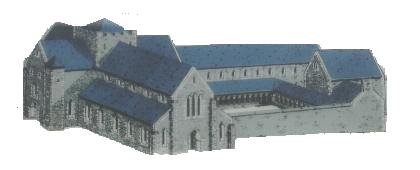| |
| |
Greyabbey
Cistercian Abbey was founded in  1193 by Affreca daughter of Godred King of the Isle of Mann and
wife of John de Courcy
an Anglo Norman Knight who ruled most of Ulster. It is said Affreca
decided to found the Abbey after enduring a particularly bad sea
crossing from the Isle of Mann, It was probably
1193 by Affreca daughter of Godred King of the Isle of Mann and
wife of John de Courcy
an Anglo Norman Knight who ruled most of Ulster. It is said Affreca
decided to found the Abbey after enduring a particularly bad sea
crossing from the Isle of Mann, It was probably the
first ecclesiastical building in Ireland to adopt the full Gothic
Style of architecture. the
first ecclesiastical building in Ireland to adopt the full Gothic
Style of architecture.
The monks came from Holm Cultram
in Cumbria and no doubt brought the architectural style with them.
It is said that Greyabbey bears resemblance to Lanercost, an Augustinian
Priory built about the same time in the Lake District of England.
The Abbey is situated just
north of the village of Greyabbey, which grew up around the Abbey.
The Latin name for the Abbey is Iugum Dei, which translated
means Yoke of God.
If you're in the locality the
Abbey is well worth a visit, the grounds are beautifully kept, there
is a herb garden with seating where you can relax to the sound of
a small stream hurrying to the nearby sea, from the herb garden
a little bridge crosses the stream giving you access to the Abbey
grounds.
|
After the Bruce wars (1315-18), Greyabbey
was controlled by the O'Neills of Clandeboye who controlled it until it
was dissolved in 1537, it is recorded that it consisted of sixteen
town lands and the rectories of two parishes, part of which was granted
to the earl of Kildare. The abbey along with others in the area were burnt
by Brian O'Neill in 1569 to prevent them giving shelter to English planters
who were attempting to colonise the area. In 1572 Elizabeth I granted the abbey and monastic lands to Sir Thomas Smith,
although he and his son also Thomas were largely unsuccessful in taking
possession.
Elizabeth I granted the abbey and monastic lands to Sir Thomas Smith,
although he and his son also Thomas were largely unsuccessful in taking
possession.
In the early seventeenth century as
part of a new plantation effort, the abbey lands were granted to Sir Hugh
Montgomery, he refurbished the nave for parish worship, it was used as
such until about 1778.
In Greyabbey village pronounced locally
by some of the older inhabitants as "Grebba" there are a few
good quality hostelry's. In 1798 the Rev. James Porter minister of the
local Presbyterian church in the town, was hanged on a temporary gallows
within sight of his church for his part in the United
Irishmen's Rebellion, his remains are interred in the graveyard adjacent
to the monastery.
Greyabbey Cistercian Abbey
Greyabbey
Co Down
Tel +44 (0)28
E Mail
Web Site |
Illustrated above
is an artists impression of how the Abbey would have looked
(See also the history of County
Down and John
de Courcy.)
Read about Greyabbey village in 1837 from
Lewis' Topographical Survey of Ireland.
Greyabbey Cistercian Abbey |
|
|




 Elizabeth I granted the abbey and monastic lands to Sir Thomas Smith,
although he and his son also Thomas were largely unsuccessful in taking
possession.
Elizabeth I granted the abbey and monastic lands to Sir Thomas Smith,
although he and his son also Thomas were largely unsuccessful in taking
possession.